Analyzing Intercultural Communication: Skills and Business Contexts
VerifiedAdded on 2023/06/04
|7
|2053
|104
Essay
AI Summary
This essay delves into the multifaceted aspects of intercultural communication, addressing three key questions. First, it examines the relationship between cultural identity and nationality, providing examples from business contexts to illustrate how national cultures shape individual identities and influence communication styles. Second, it identifies essential skills for managers to be competent in intercultural communication, such as understanding cultural differences, adaptability, multilingualism, and effective negotiation techniques. Finally, the essay discusses the complexities inherent in intercultural business communication, including language barriers, differing communication styles, and the potential for misunderstandings arising from cultural variances. It highlights the importance of cultural awareness and sensitivity in fostering effective communication and building strong relationships in diverse business environments. The document is available on Desklib, a platform offering a wide range of academic resources for students.
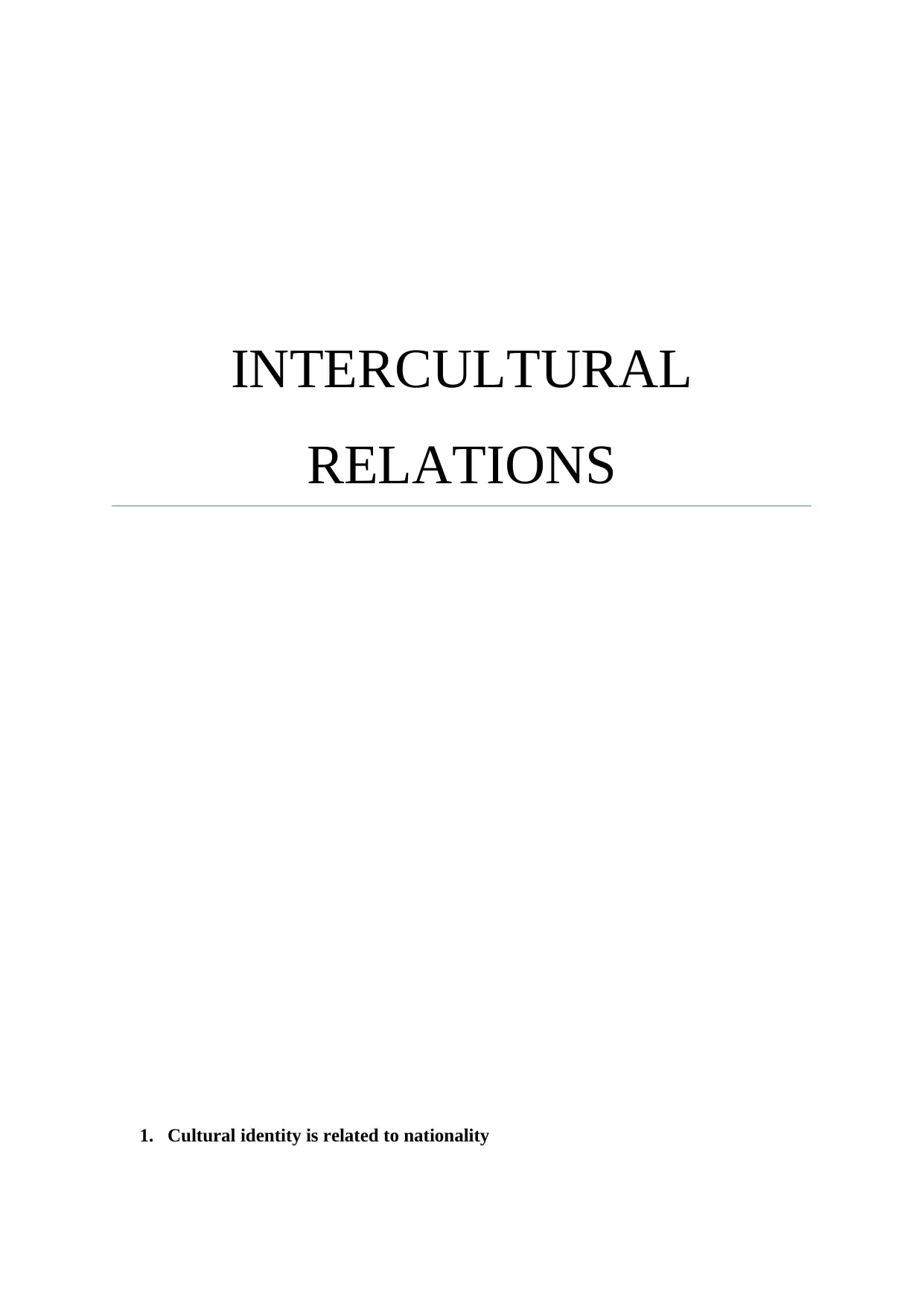
INTERCULTURAL
RELATIONS
1. Cultural identity is related to nationality
RELATIONS
1. Cultural identity is related to nationality
Paraphrase This Document
Need a fresh take? Get an instant paraphrase of this document with our AI Paraphraser
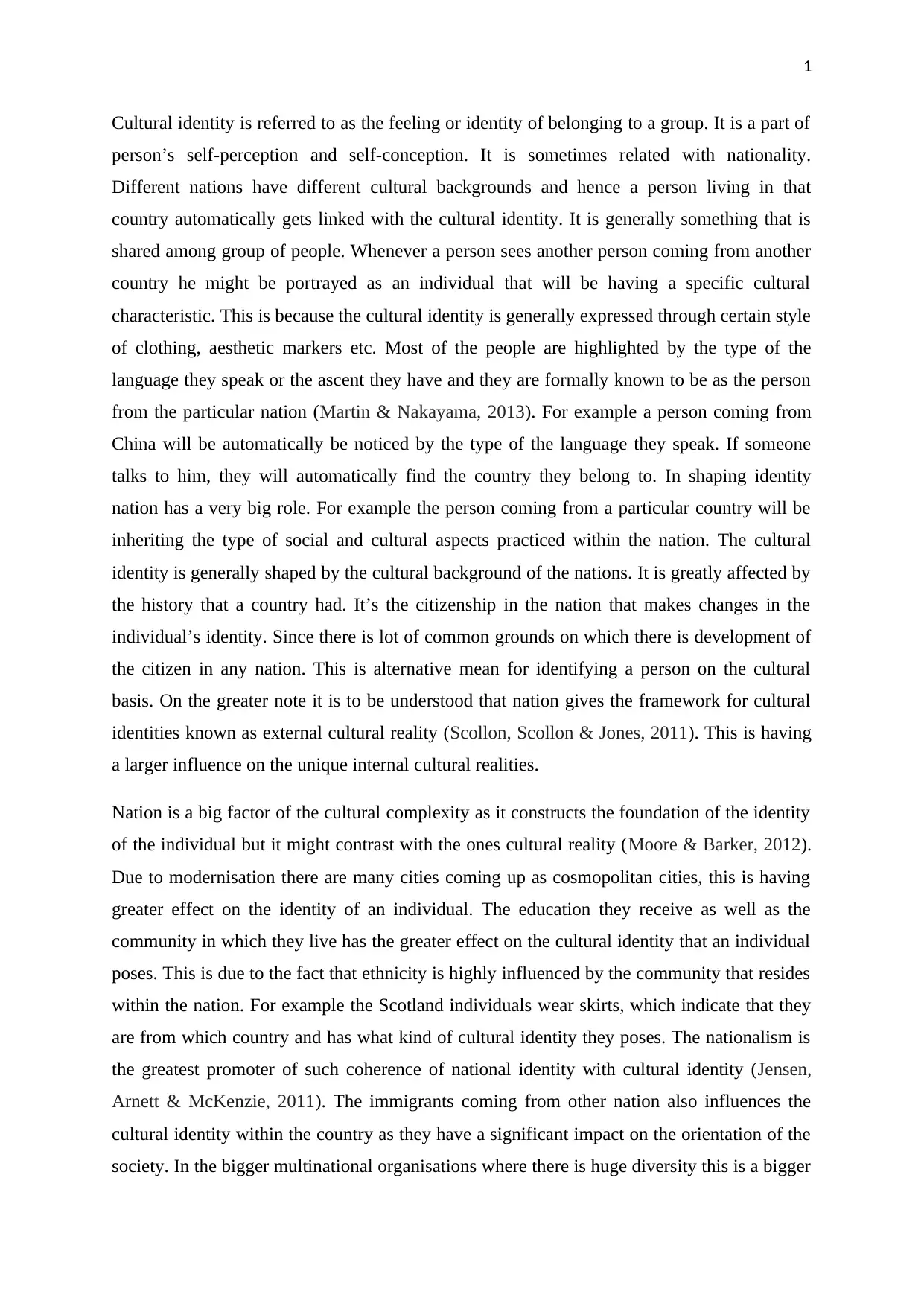
1
Cultural identity is referred to as the feeling or identity of belonging to a group. It is a part of
person’s self-perception and self-conception. It is sometimes related with nationality.
Different nations have different cultural backgrounds and hence a person living in that
country automatically gets linked with the cultural identity. It is generally something that is
shared among group of people. Whenever a person sees another person coming from another
country he might be portrayed as an individual that will be having a specific cultural
characteristic. This is because the cultural identity is generally expressed through certain style
of clothing, aesthetic markers etc. Most of the people are highlighted by the type of the
language they speak or the ascent they have and they are formally known to be as the person
from the particular nation (Martin & Nakayama, 2013). For example a person coming from
China will be automatically be noticed by the type of the language they speak. If someone
talks to him, they will automatically find the country they belong to. In shaping identity
nation has a very big role. For example the person coming from a particular country will be
inheriting the type of social and cultural aspects practiced within the nation. The cultural
identity is generally shaped by the cultural background of the nations. It is greatly affected by
the history that a country had. It’s the citizenship in the nation that makes changes in the
individual’s identity. Since there is lot of common grounds on which there is development of
the citizen in any nation. This is alternative mean for identifying a person on the cultural
basis. On the greater note it is to be understood that nation gives the framework for cultural
identities known as external cultural reality (Scollon, Scollon & Jones, 2011). This is having
a larger influence on the unique internal cultural realities.
Nation is a big factor of the cultural complexity as it constructs the foundation of the identity
of the individual but it might contrast with the ones cultural reality (Moore & Barker, 2012).
Due to modernisation there are many cities coming up as cosmopolitan cities, this is having
greater effect on the identity of an individual. The education they receive as well as the
community in which they live has the greater effect on the cultural identity that an individual
poses. This is due to the fact that ethnicity is highly influenced by the community that resides
within the nation. For example the Scotland individuals wear skirts, which indicate that they
are from which country and has what kind of cultural identity they poses. The nationalism is
the greatest promoter of such coherence of national identity with cultural identity (Jensen,
Arnett & McKenzie, 2011). The immigrants coming from other nation also influences the
cultural identity within the country as they have a significant impact on the orientation of the
society. In the bigger multinational organisations where there is huge diversity this is a bigger
Cultural identity is referred to as the feeling or identity of belonging to a group. It is a part of
person’s self-perception and self-conception. It is sometimes related with nationality.
Different nations have different cultural backgrounds and hence a person living in that
country automatically gets linked with the cultural identity. It is generally something that is
shared among group of people. Whenever a person sees another person coming from another
country he might be portrayed as an individual that will be having a specific cultural
characteristic. This is because the cultural identity is generally expressed through certain style
of clothing, aesthetic markers etc. Most of the people are highlighted by the type of the
language they speak or the ascent they have and they are formally known to be as the person
from the particular nation (Martin & Nakayama, 2013). For example a person coming from
China will be automatically be noticed by the type of the language they speak. If someone
talks to him, they will automatically find the country they belong to. In shaping identity
nation has a very big role. For example the person coming from a particular country will be
inheriting the type of social and cultural aspects practiced within the nation. The cultural
identity is generally shaped by the cultural background of the nations. It is greatly affected by
the history that a country had. It’s the citizenship in the nation that makes changes in the
individual’s identity. Since there is lot of common grounds on which there is development of
the citizen in any nation. This is alternative mean for identifying a person on the cultural
basis. On the greater note it is to be understood that nation gives the framework for cultural
identities known as external cultural reality (Scollon, Scollon & Jones, 2011). This is having
a larger influence on the unique internal cultural realities.
Nation is a big factor of the cultural complexity as it constructs the foundation of the identity
of the individual but it might contrast with the ones cultural reality (Moore & Barker, 2012).
Due to modernisation there are many cities coming up as cosmopolitan cities, this is having
greater effect on the identity of an individual. The education they receive as well as the
community in which they live has the greater effect on the cultural identity that an individual
poses. This is due to the fact that ethnicity is highly influenced by the community that resides
within the nation. For example the Scotland individuals wear skirts, which indicate that they
are from which country and has what kind of cultural identity they poses. The nationalism is
the greatest promoter of such coherence of national identity with cultural identity (Jensen,
Arnett & McKenzie, 2011). The immigrants coming from other nation also influences the
cultural identity within the country as they have a significant impact on the orientation of the
society. In the bigger multinational organisations where there is huge diversity this is a bigger
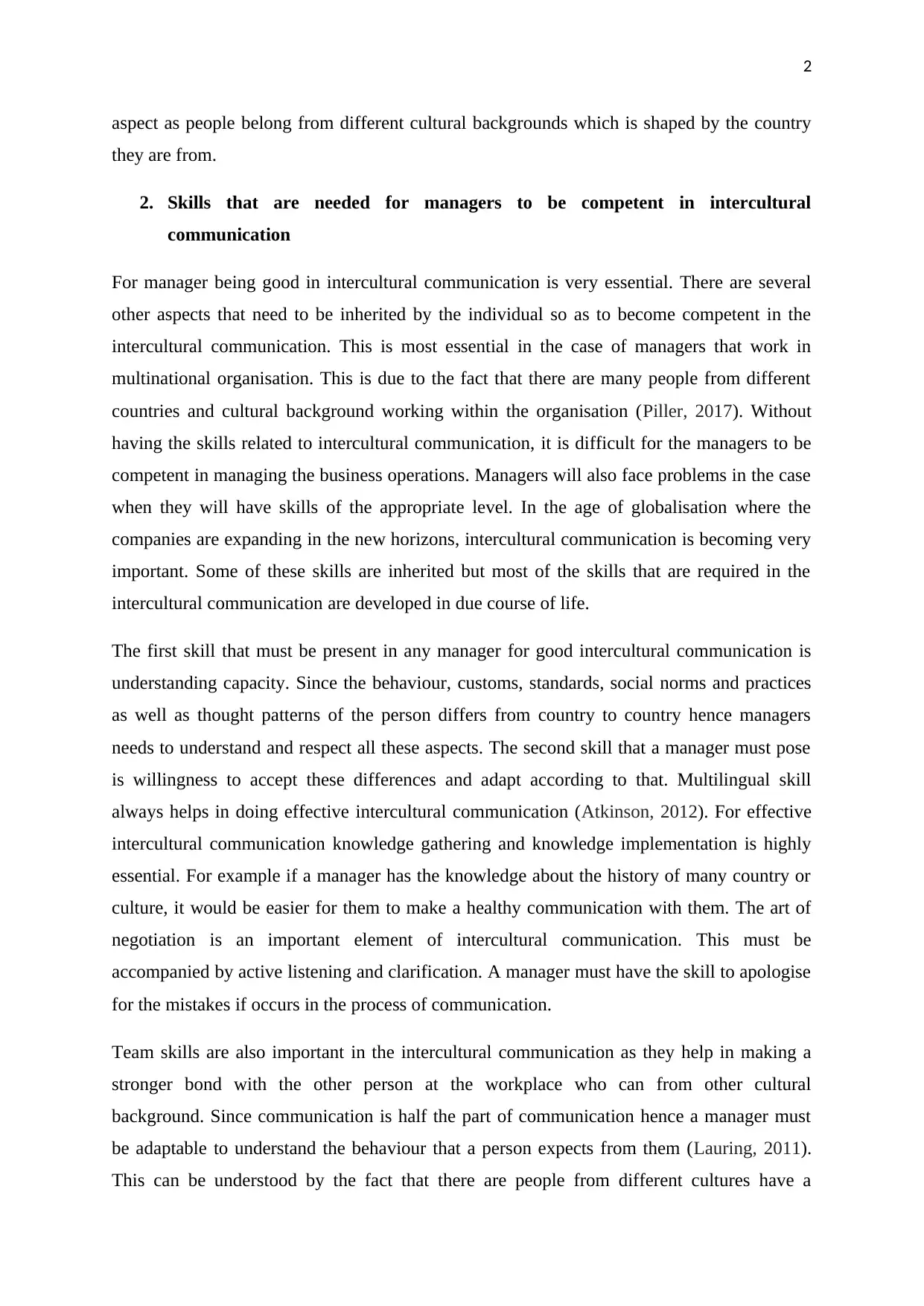
2
aspect as people belong from different cultural backgrounds which is shaped by the country
they are from.
2. Skills that are needed for managers to be competent in intercultural
communication
For manager being good in intercultural communication is very essential. There are several
other aspects that need to be inherited by the individual so as to become competent in the
intercultural communication. This is most essential in the case of managers that work in
multinational organisation. This is due to the fact that there are many people from different
countries and cultural background working within the organisation (Piller, 2017). Without
having the skills related to intercultural communication, it is difficult for the managers to be
competent in managing the business operations. Managers will also face problems in the case
when they will have skills of the appropriate level. In the age of globalisation where the
companies are expanding in the new horizons, intercultural communication is becoming very
important. Some of these skills are inherited but most of the skills that are required in the
intercultural communication are developed in due course of life.
The first skill that must be present in any manager for good intercultural communication is
understanding capacity. Since the behaviour, customs, standards, social norms and practices
as well as thought patterns of the person differs from country to country hence managers
needs to understand and respect all these aspects. The second skill that a manager must pose
is willingness to accept these differences and adapt according to that. Multilingual skill
always helps in doing effective intercultural communication (Atkinson, 2012). For effective
intercultural communication knowledge gathering and knowledge implementation is highly
essential. For example if a manager has the knowledge about the history of many country or
culture, it would be easier for them to make a healthy communication with them. The art of
negotiation is an important element of intercultural communication. This must be
accompanied by active listening and clarification. A manager must have the skill to apologise
for the mistakes if occurs in the process of communication.
Team skills are also important in the intercultural communication as they help in making a
stronger bond with the other person at the workplace who can from other cultural
background. Since communication is half the part of communication hence a manager must
be adaptable to understand the behaviour that a person expects from them (Lauring, 2011).
This can be understood by the fact that there are people from different cultures have a
aspect as people belong from different cultural backgrounds which is shaped by the country
they are from.
2. Skills that are needed for managers to be competent in intercultural
communication
For manager being good in intercultural communication is very essential. There are several
other aspects that need to be inherited by the individual so as to become competent in the
intercultural communication. This is most essential in the case of managers that work in
multinational organisation. This is due to the fact that there are many people from different
countries and cultural background working within the organisation (Piller, 2017). Without
having the skills related to intercultural communication, it is difficult for the managers to be
competent in managing the business operations. Managers will also face problems in the case
when they will have skills of the appropriate level. In the age of globalisation where the
companies are expanding in the new horizons, intercultural communication is becoming very
important. Some of these skills are inherited but most of the skills that are required in the
intercultural communication are developed in due course of life.
The first skill that must be present in any manager for good intercultural communication is
understanding capacity. Since the behaviour, customs, standards, social norms and practices
as well as thought patterns of the person differs from country to country hence managers
needs to understand and respect all these aspects. The second skill that a manager must pose
is willingness to accept these differences and adapt according to that. Multilingual skill
always helps in doing effective intercultural communication (Atkinson, 2012). For effective
intercultural communication knowledge gathering and knowledge implementation is highly
essential. For example if a manager has the knowledge about the history of many country or
culture, it would be easier for them to make a healthy communication with them. The art of
negotiation is an important element of intercultural communication. This must be
accompanied by active listening and clarification. A manager must have the skill to apologise
for the mistakes if occurs in the process of communication.
Team skills are also important in the intercultural communication as they help in making a
stronger bond with the other person at the workplace who can from other cultural
background. Since communication is half the part of communication hence a manager must
be adaptable to understand the behaviour that a person expects from them (Lauring, 2011).
This can be understood by the fact that there are people from different cultures have a
⊘ This is a preview!⊘
Do you want full access?
Subscribe today to unlock all pages.

Trusted by 1+ million students worldwide
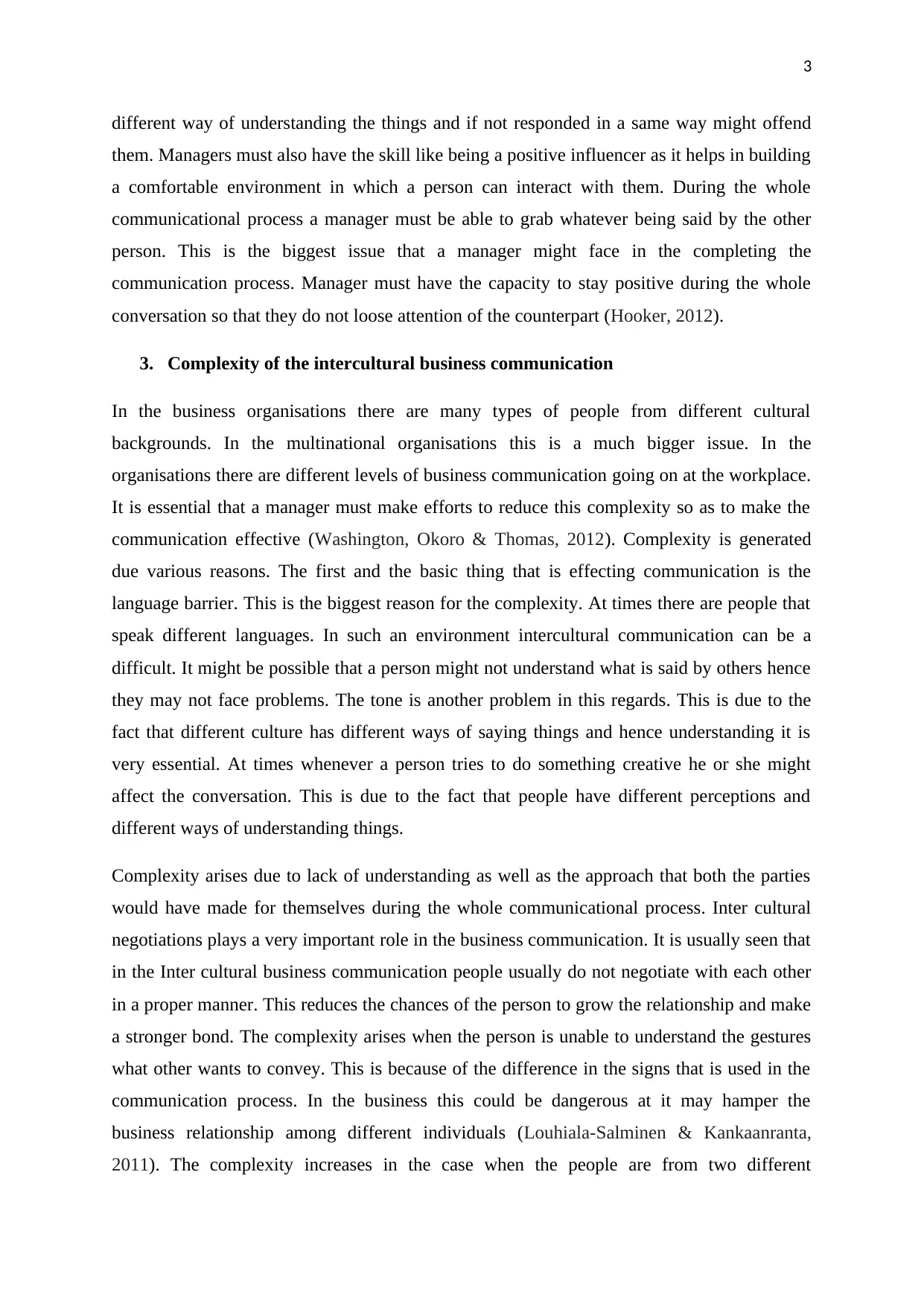
3
different way of understanding the things and if not responded in a same way might offend
them. Managers must also have the skill like being a positive influencer as it helps in building
a comfortable environment in which a person can interact with them. During the whole
communicational process a manager must be able to grab whatever being said by the other
person. This is the biggest issue that a manager might face in the completing the
communication process. Manager must have the capacity to stay positive during the whole
conversation so that they do not loose attention of the counterpart (Hooker, 2012).
3. Complexity of the intercultural business communication
In the business organisations there are many types of people from different cultural
backgrounds. In the multinational organisations this is a much bigger issue. In the
organisations there are different levels of business communication going on at the workplace.
It is essential that a manager must make efforts to reduce this complexity so as to make the
communication effective (Washington, Okoro & Thomas, 2012). Complexity is generated
due various reasons. The first and the basic thing that is effecting communication is the
language barrier. This is the biggest reason for the complexity. At times there are people that
speak different languages. In such an environment intercultural communication can be a
difficult. It might be possible that a person might not understand what is said by others hence
they may not face problems. The tone is another problem in this regards. This is due to the
fact that different culture has different ways of saying things and hence understanding it is
very essential. At times whenever a person tries to do something creative he or she might
affect the conversation. This is due to the fact that people have different perceptions and
different ways of understanding things.
Complexity arises due to lack of understanding as well as the approach that both the parties
would have made for themselves during the whole communicational process. Inter cultural
negotiations plays a very important role in the business communication. It is usually seen that
in the Inter cultural business communication people usually do not negotiate with each other
in a proper manner. This reduces the chances of the person to grow the relationship and make
a stronger bond. The complexity arises when the person is unable to understand the gestures
what other wants to convey. This is because of the difference in the signs that is used in the
communication process. In the business this could be dangerous at it may hamper the
business relationship among different individuals (Louhiala-Salminen & Kankaanranta,
2011). The complexity increases in the case when the people are from two different
different way of understanding the things and if not responded in a same way might offend
them. Managers must also have the skill like being a positive influencer as it helps in building
a comfortable environment in which a person can interact with them. During the whole
communicational process a manager must be able to grab whatever being said by the other
person. This is the biggest issue that a manager might face in the completing the
communication process. Manager must have the capacity to stay positive during the whole
conversation so that they do not loose attention of the counterpart (Hooker, 2012).
3. Complexity of the intercultural business communication
In the business organisations there are many types of people from different cultural
backgrounds. In the multinational organisations this is a much bigger issue. In the
organisations there are different levels of business communication going on at the workplace.
It is essential that a manager must make efforts to reduce this complexity so as to make the
communication effective (Washington, Okoro & Thomas, 2012). Complexity is generated
due various reasons. The first and the basic thing that is effecting communication is the
language barrier. This is the biggest reason for the complexity. At times there are people that
speak different languages. In such an environment intercultural communication can be a
difficult. It might be possible that a person might not understand what is said by others hence
they may not face problems. The tone is another problem in this regards. This is due to the
fact that different culture has different ways of saying things and hence understanding it is
very essential. At times whenever a person tries to do something creative he or she might
affect the conversation. This is due to the fact that people have different perceptions and
different ways of understanding things.
Complexity arises due to lack of understanding as well as the approach that both the parties
would have made for themselves during the whole communicational process. Inter cultural
negotiations plays a very important role in the business communication. It is usually seen that
in the Inter cultural business communication people usually do not negotiate with each other
in a proper manner. This reduces the chances of the person to grow the relationship and make
a stronger bond. The complexity arises when the person is unable to understand the gestures
what other wants to convey. This is because of the difference in the signs that is used in the
communication process. In the business this could be dangerous at it may hamper the
business relationship among different individuals (Louhiala-Salminen & Kankaanranta,
2011). The complexity increases in the case when the people are from two different
Paraphrase This Document
Need a fresh take? Get an instant paraphrase of this document with our AI Paraphraser
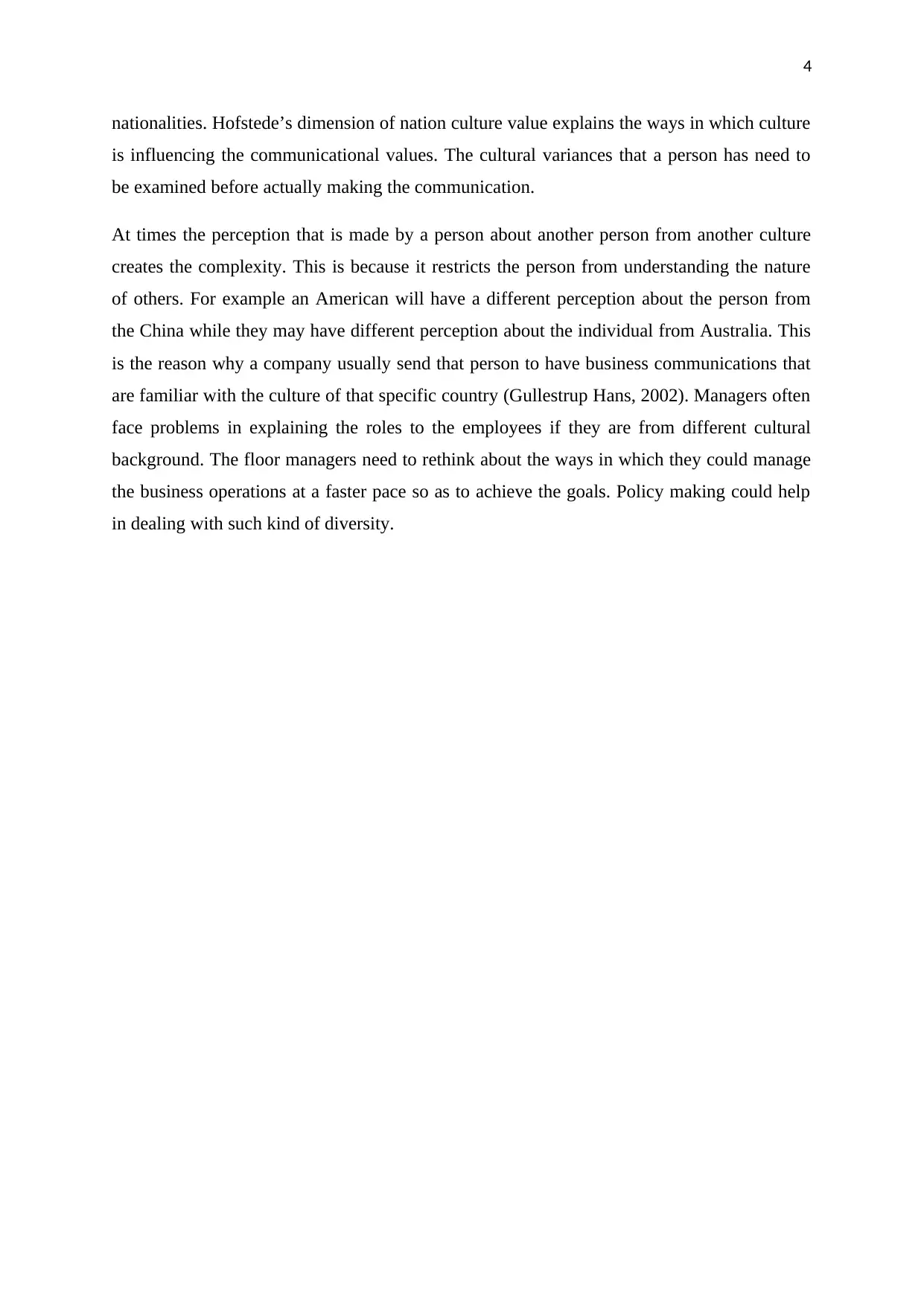
4
nationalities. Hofstede’s dimension of nation culture value explains the ways in which culture
is influencing the communicational values. The cultural variances that a person has need to
be examined before actually making the communication.
At times the perception that is made by a person about another person from another culture
creates the complexity. This is because it restricts the person from understanding the nature
of others. For example an American will have a different perception about the person from
the China while they may have different perception about the individual from Australia. This
is the reason why a company usually send that person to have business communications that
are familiar with the culture of that specific country (Gullestrup Hans, 2002). Managers often
face problems in explaining the roles to the employees if they are from different cultural
background. The floor managers need to rethink about the ways in which they could manage
the business operations at a faster pace so as to achieve the goals. Policy making could help
in dealing with such kind of diversity.
nationalities. Hofstede’s dimension of nation culture value explains the ways in which culture
is influencing the communicational values. The cultural variances that a person has need to
be examined before actually making the communication.
At times the perception that is made by a person about another person from another culture
creates the complexity. This is because it restricts the person from understanding the nature
of others. For example an American will have a different perception about the person from
the China while they may have different perception about the individual from Australia. This
is the reason why a company usually send that person to have business communications that
are familiar with the culture of that specific country (Gullestrup Hans, 2002). Managers often
face problems in explaining the roles to the employees if they are from different cultural
background. The floor managers need to rethink about the ways in which they could manage
the business operations at a faster pace so as to achieve the goals. Policy making could help
in dealing with such kind of diversity.
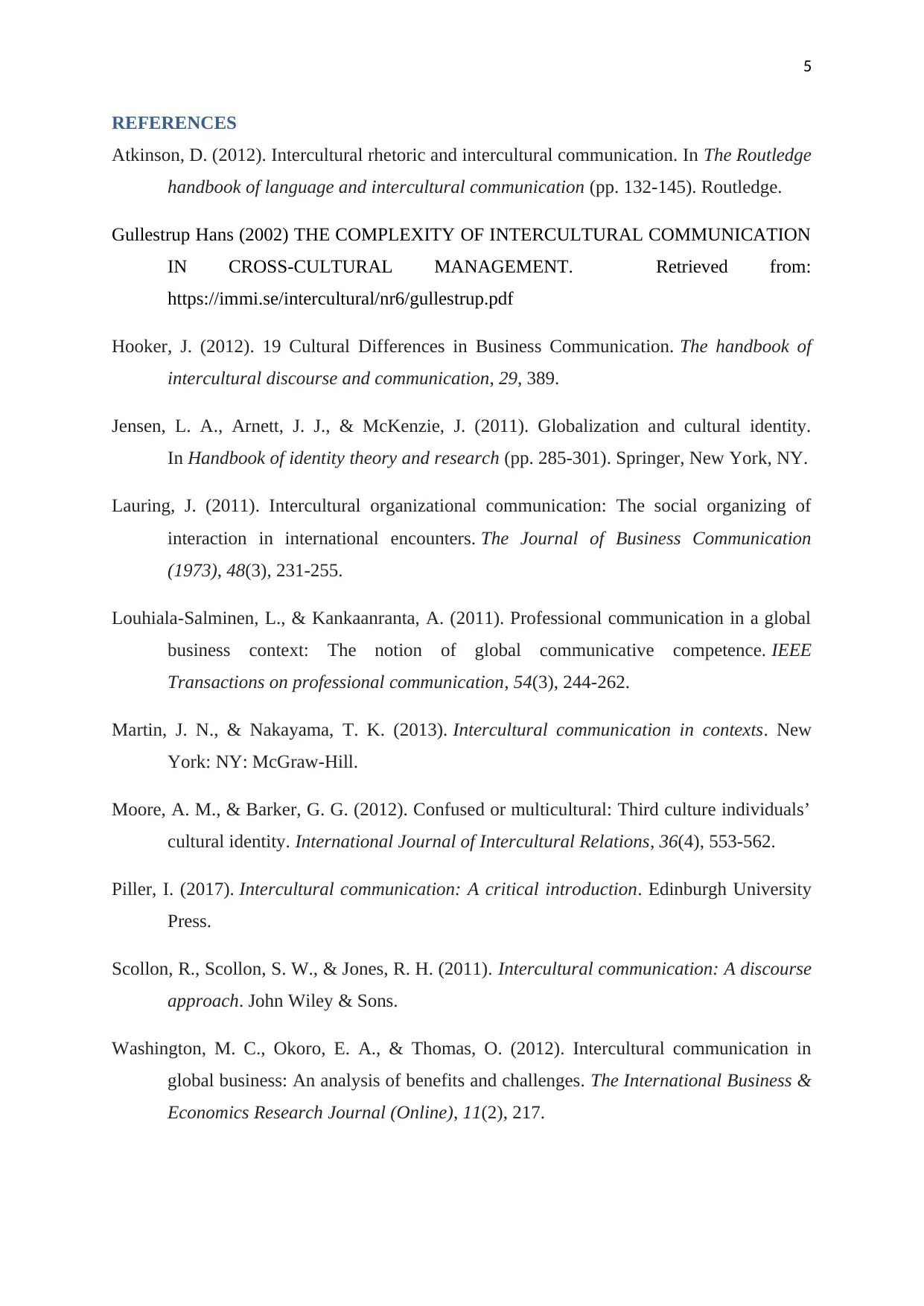
5
REFERENCES
Atkinson, D. (2012). Intercultural rhetoric and intercultural communication. In The Routledge
handbook of language and intercultural communication (pp. 132-145). Routledge.
Gullestrup Hans (2002) THE COMPLEXITY OF INTERCULTURAL COMMUNICATION
IN CROSS-CULTURAL MANAGEMENT. Retrieved from:
https://immi.se/intercultural/nr6/gullestrup.pdf
Hooker, J. (2012). 19 Cultural Differences in Business Communication. The handbook of
intercultural discourse and communication, 29, 389.
Jensen, L. A., Arnett, J. J., & McKenzie, J. (2011). Globalization and cultural identity.
In Handbook of identity theory and research (pp. 285-301). Springer, New York, NY.
Lauring, J. (2011). Intercultural organizational communication: The social organizing of
interaction in international encounters. The Journal of Business Communication
(1973), 48(3), 231-255.
Louhiala-Salminen, L., & Kankaanranta, A. (2011). Professional communication in a global
business context: The notion of global communicative competence. IEEE
Transactions on professional communication, 54(3), 244-262.
Martin, J. N., & Nakayama, T. K. (2013). Intercultural communication in contexts. New
York: NY: McGraw-Hill.
Moore, A. M., & Barker, G. G. (2012). Confused or multicultural: Third culture individuals’
cultural identity. International Journal of Intercultural Relations, 36(4), 553-562.
Piller, I. (2017). Intercultural communication: A critical introduction. Edinburgh University
Press.
Scollon, R., Scollon, S. W., & Jones, R. H. (2011). Intercultural communication: A discourse
approach. John Wiley & Sons.
Washington, M. C., Okoro, E. A., & Thomas, O. (2012). Intercultural communication in
global business: An analysis of benefits and challenges. The International Business &
Economics Research Journal (Online), 11(2), 217.
REFERENCES
Atkinson, D. (2012). Intercultural rhetoric and intercultural communication. In The Routledge
handbook of language and intercultural communication (pp. 132-145). Routledge.
Gullestrup Hans (2002) THE COMPLEXITY OF INTERCULTURAL COMMUNICATION
IN CROSS-CULTURAL MANAGEMENT. Retrieved from:
https://immi.se/intercultural/nr6/gullestrup.pdf
Hooker, J. (2012). 19 Cultural Differences in Business Communication. The handbook of
intercultural discourse and communication, 29, 389.
Jensen, L. A., Arnett, J. J., & McKenzie, J. (2011). Globalization and cultural identity.
In Handbook of identity theory and research (pp. 285-301). Springer, New York, NY.
Lauring, J. (2011). Intercultural organizational communication: The social organizing of
interaction in international encounters. The Journal of Business Communication
(1973), 48(3), 231-255.
Louhiala-Salminen, L., & Kankaanranta, A. (2011). Professional communication in a global
business context: The notion of global communicative competence. IEEE
Transactions on professional communication, 54(3), 244-262.
Martin, J. N., & Nakayama, T. K. (2013). Intercultural communication in contexts. New
York: NY: McGraw-Hill.
Moore, A. M., & Barker, G. G. (2012). Confused or multicultural: Third culture individuals’
cultural identity. International Journal of Intercultural Relations, 36(4), 553-562.
Piller, I. (2017). Intercultural communication: A critical introduction. Edinburgh University
Press.
Scollon, R., Scollon, S. W., & Jones, R. H. (2011). Intercultural communication: A discourse
approach. John Wiley & Sons.
Washington, M. C., Okoro, E. A., & Thomas, O. (2012). Intercultural communication in
global business: An analysis of benefits and challenges. The International Business &
Economics Research Journal (Online), 11(2), 217.
⊘ This is a preview!⊘
Do you want full access?
Subscribe today to unlock all pages.

Trusted by 1+ million students worldwide

6
1 out of 7
Related Documents
Your All-in-One AI-Powered Toolkit for Academic Success.
+13062052269
info@desklib.com
Available 24*7 on WhatsApp / Email
![[object Object]](/_next/static/media/star-bottom.7253800d.svg)
Unlock your academic potential
Copyright © 2020–2025 A2Z Services. All Rights Reserved. Developed and managed by ZUCOL.





